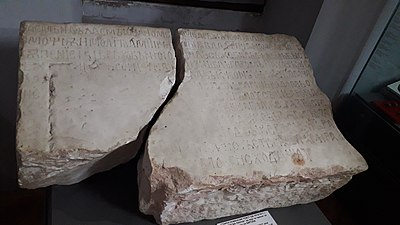Bitola Yazıtı
Bitola yazıtı, Birinci Bulgar İmparatorluğu'na ait Eski Kilise Slavcası dilinde Kiril alfabesi ile yazılmış bir taş yazıttır.[1] Şu anda, Kuzey Makedonya'daki Manastır Enstitüsü ve Müzesi'nde, "1015/17'den İvan Vladislav'ın Kiril mektuplarının bulunduğu mermer levha" olarak tanımlanan önemli bir epigrafik anıt olarak kalıcı sergiler arasında yer almaktadır.[2] Bizans İmparatorluğu'nun Bulgaristan'ı fethi son aşamalarında İvan Vladislav, son tahkimatını yenilemeyi ve güçlendirmeyi başarmasını bu ayrıntılı yazıtla anmıştır.[3] 1956'da bulunan yazıt, Samuil devletinin, Yugoslav bilim adamları tarafından tartışılan Bulgar karakterini destekleyen güçlü argümanlar sağladı.[4] Ana akım akademik görüş, yazıtın Ivan Vladislav yönetimi sırasında yapılmış orijinal bir eser olduğu yönündedir.[5]



Kaynakça
değiştir- ^ Vasilka Tăpkova-Zaimova, Bulgarians by Birth: The Comitopuls, Emperor Samuel and their Successors According to Historical Sources and the Historiographic Tradition, East Central and Eastern Europe in the Middle Ages, 450–1450, BRILL, 2018, 9004352996, pp. 17–18.
- ^ "Among the most significant findings of this period presented in the permanent exhibition is the epigraphic monument a marble slab with Cyrillic letters of Jovan Vladislav from 1015/17." The official site of the Institute for preservation of monuments of culture, Museum and Gallery Bitola 21 Haziran 2023 tarihinde Wayback Machine sitesinde arşivlendi.
- ^ Jonathan Shepard, Equilibrium to Expansion (886–1025); pp 493-536; from Part II - The Middle Empire c. 700–1204 in The Cambridge History of the Byzantine Empire C.500-1492 (2008) Cambridge University Press, p. 529, 0521832314.
- ^ Roumen Daskalov (2021) Master Narratives of the Middle Ages in Bulgaria, East Central and Eastern Europe in the Middle Ages, 450-1450, BRILL, pp. 226-227, 9004464875.
- ^ * Historical Dictionary of the Republic of Macedonia, Dimitar Bechev, Scarecrow Press, 2009 0810855658, p. 195.
- Reuter, Timothy, (Ed.) (2000). The New Cambridge Medieval History, Volume 3, c.900–c.1024 (İngilizce). Cambridge: Cambridge University Press. s. 600. ISBN 978-1-13905572-7.
- Mango, Cyril ed. (2002). The Oxford History of Byzantium 17 Ağustos 2023 tarihinde Wayback Machine sitesinde arşivlendi.. OUP Oxford. 0-19-814098-3, p. 238.
- The legend of Basil the Bulgar-slayer 21 Haziran 2023 tarihinde Wayback Machine sitesinde arşivlendi., Paul Stephenson, Cambridge University Press, 2003, 0-521-81530-4, pp. 29–30.
- Southeastern Europe in the Middle Ages, 500–1250 21 Haziran 2023 tarihinde Wayback Machine sitesinde arşivlendi., Cambridge medieval textbooks, Florin Curta, Cambridge University Press, 2006, 0-521-81539-8, p. 246.
- Basil II and the governance of Empire (976–1025) 23 Haziran 2023 tarihinde Wayback Machine sitesinde arşivlendi., Oxford studies in Byzantium, Catherine Holmes, Oxford University Press, 2005, 0-19-927968-3, pp. 56–57.
- Das makedonische Jahrhundert: von den Anfängen der nationalrevolutionären Bewegung zum Abkommen von Ohrid 1893–2001[ölü/kırık bağlantı]; ausgewählte Aufsätze, Stefan Troebst, Oldenbourg Wissenschaftsverlag, 2007, 3-486-58050-7, S. 414.
- Krieg und Kriegführung in Byzanz: Die Kriege Kaiser Basileios II. Gegen die Bulgaren (976–1019) 21 Haziran 2023 tarihinde Wayback Machine sitesinde arşivlendi., Paul Meinrad Strässle, Böhlau Verlag Köln Weimar 2006, 341217405X, p. 172.
- Византийский временник, Институт истории (Академия наук СССР), Институт славяноведения и балканистики (Академия наук СССР), Институт всеобщей истории (Российская академия наук) Изд-во Академии наук СССР, 1973, стр. 266. 17 Ağustos 2023 tarihinde Wayback Machine sitesinde arşivlendi.
- Bŭlgarski ezik, Institut za bŭlgarski ezik (Bŭlgarska akademiia na naukite) 1981, p. 372.
- Срђан Пириватрић, „Самуилова држава. Обим и карактер", Византолошки институт Српске академије науке и уметности, посебна издања књига 21, Београд, 1997, стр. 183.
- Ivan Vladislav. In Prosopographie der mittelbyzantinischen Zeit (2013). Berlin, Boston: De Gruyter. Retrieved February 19, 2019.
- Иван Микулчиќ, Средновековни градови и тврдини во Македонија. (Македонска академија на науките и уметностите — Скопје, 1996), стр. 140–141.